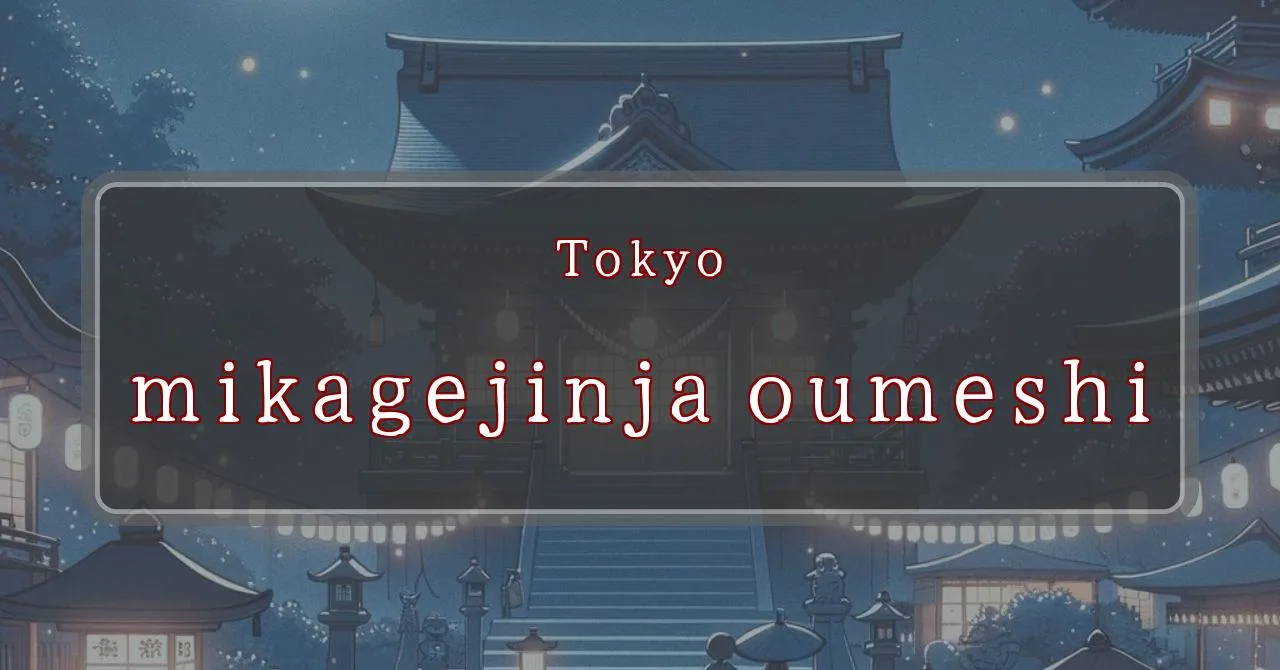Enchanting Shrine Festival in Ome City
Basic Information
Mikage Shrine is a shrine located in Ome City, Tokyo, Japan. It is dedicated to the deities Ōkuninushi and Sukunabikona, and is said to have been founded in the 7th century.
- Address: 2-480 Mikage, Ome, Tokyo 198-0033, Japan
- Phone Number: 0428-78-8554
- Access: 1-minute walk from Takimoto Station
- Festival Days: None
Main Events and Attractions of the Festival
Mikage Shrine is a Shinto shrine located in Ome City, Tokyo, Japan. It is dedicated to the deities Ōkuninushi and Sukunabikona, and is said to have been founded in the 7th century. The shrine is known for its beautiful scenery and its many festivals and events throughout the year.
Mikage Shrine Annual Festival
The Mikage Shrine Annual Festival is held every year on November 8th. The festival features a variety of events and attractions, including:
- Mikoshi Procession: A portable shrine is carried through the streets of Ome City by local residents.
- Kagura Performance: A traditional Japanese dance and music performance is held at the shrine.
- Food Stalls: A variety of food stalls are set up around the shrine, selling traditional Japanese dishes and snacks.
- Games and Activities: There are a variety of games and activities for children and adults to enjoy, such as ring toss and archery.
Other Events and Attractions
In addition to the annual festival, Mikage Shrine also hosts a number of other events and attractions throughout the year, including:
- Setsubun Festival: This festival is held in February and features a bean-throwing ceremony to ward off evil spirits and bring good luck.
- Hina Matsuri: This festival is held in March and features a display of hina dolls, which are traditional Japanese dolls that represent the Emperor and Empress.
- Children’s Day: This festival is held in May and features a variety of events and activities for children, such as face painting and balloon animals.
Blessings and Deities
Mikage Shrine is dedicated to the deities Ōkuninushi and Sukunabikona. Ōkuninushi is a major deity in Japanese mythology, known as the god of nation-building, agriculture, and medicine. Sukunabikona is a deity of medicine and healing.
- Ōkuninushi: God of nation-building, agriculture, and medicine
- Sukunabikona: Deity of medicine and healing
Origin and History
The exact date of Mikage Shrine’s founding is unknown, but it is believed to have been established in the 7th century. The shrine was originally located in a different part of Ome City, but it was moved to its current location in 1661.
- Founded: 7th century
- Moved to current location: 1661
Tips and Notes for Visitors
Mikage Shrine is a popular destination for visitors, especially during its annual festival in November. Here are some tips and notes for visitors:
- Wear comfortable shoes: You will be doing a lot of walking, so make sure to wear comfortable shoes.
- Bring cash: There are no ATMs at the shrine, so make sure to bring cash for food, drinks, and souvenirs.
- Be respectful: Mikage Shrine is a sacred place, so be respectful of the shrine and its visitors.
Parking Information
There is no dedicated parking lot for Mikage Shrine. However, there are several public parking lots nearby.
- Ome City Hall Parking Lot: A 5-minute walk from the shrine
- Ome Station Parking Lot: A 10-minute walk from the shrine
- Mikage Shrine Parking Lot: A 15-minute walk from the shrine
Popular Stalls and Food Carts in Recent Years
| Type of Stall | Description |
|---|---|
| Takoyaki | A staple at Japanese festivals. Characterized by a crispy outside and a creamy inside. |
| Jaga Butter | A simple yet popular snack of hot potatoes lavishly topped with melted butter. |
| Baby Castella | Small castella cakes, sweet and fluffy treats enjoyed by children and adults alike. |
| Grilled Ayu with Salt | Fresh ayu fish grilled whole with salt, a savory taste of Japanese summer. |
| Shaapin | A unique gourmet item influenced by foreign cuisine, with a chewy skin wrapping the filling. |
| Okonomiyaki | A Japanese grilled dish where you often choose your own ingredients for a personalized flavor. |
| Cotton Candy | A fluffy, sweet snack that’s extremely popular with children. |
| Chocolate Banana | A banana coated in chocolate, a fun and visually appealing dessert. |
| Kushiyaki | Various types of ingredients skewered and grilled, an easy-to-enjoy snack. |
| Yakisoba | Fried noodles mixed with a special sauce, a fast food favorite in Japan. |



